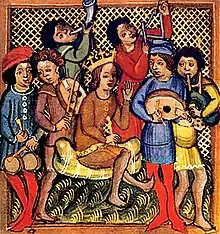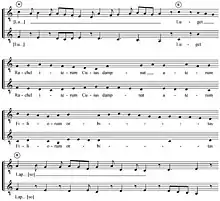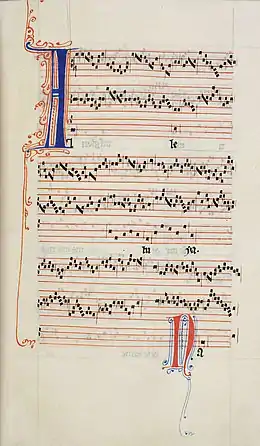Conductus
The conductus (plural: conducti) was a sacred Latin song in the Middle Ages, one whose poetry and music were newly composed. It is non-liturgical since its Latin lyric borrows little from previous chants. The conductus was northern French equivalent of the versus, which flourished in Aquitaine. It was originally found in the twelfth-century Aquitanian repertories. But major collections of conducti were preserved in Paris. The conductus typically includes one, two, or three voices. A small number of the conducti are for four voices. Stylistically, the conductus is a type of discant (i.e. note-against-note polyphony). Its form can be strophic or through-composed form. The genre flourished from the early twelfth century to the middle of thirteenth century. It was one of the principal types of vocal composition of the ars antiqua period of medieval music history.
| Part of a series on |
| Medieval music |
|---|
| Overview |
|
|

History
Origins of the name

The conductus was most likely sung while the lectionary was carried from its place of safekeeping to the place from which it was to be read. But the origins of the term "conductus" remain obscure. The noun is derived from the verb conducere, which can mean to lead, guide, or escort. Thus according to one hypothesis, the genre was called "conductus" because it served to accompany a procession. For example, according to the record of manuscript in the Institución Colombina, Seville, the conductus Salve festa dies was used for the same role of procession as the ancient hymn. The hymn with the same name was sung during the procession to the altar. But conducere can also mean "to bring together" or "join together."[1] Thus according to another hypothesis, the genre was called "conductus" because it brings sequence or hymn together.[1] The conductus is based on a condensed version of a sequence or hymn. For instance, the conductus Orienti oriens is derived from the sequence Noster cetus iste letus.
Development
The genre of the conductus most likely originated in the south of France around 1150 and reached its peak development during the activity of the Notre Dame School in the early thirteenth century. The conductus is the northern counterpart of the versus. In some sources, the versus and conductus can be interchangeably used, since both of them are strophic and accentual Latin poems. However, the conductus might be different from Aquitanian versus due to its inclusion of a caudae at the end. The melismatic flourish (caudae) in the conductus can separate the text out and disrupt the overall structure while Aquitanian melismas keeps the flow going.[2]
Much of the surviving repertoire is contained in the Florence Manuscript and also the manuscript Wolfenbüttel 1099.[3] In early documents, the conductus was often called "Benedicamus trope" or "benedictio."[4] The early conducti are simple and free from the section of melismatic flourishes known as caudae. Caudae appear more often in conducti composed after 1200. Most conducti in the large thirteenth-century manuscript collections from Notre Dame are for two or three voices.
Authorship
Many but not all conducti are anonymous. Some are attributed to some well-known poets and musicians of the time, such as Philip the Chancellor, Walter of Châtillon, Bernard of Clairvaux, Peter of Blois, and Perotinus. For instance, the text of the conductus Beata viscera was written by Philip the Chacellor and its music was attributed to Perotinus.
Common subjects of the poems are the lives of the saints, feasts of the Lord, the Nativity, as well as more current subjects such as exemplary behavior of contemporary witnesses to the faith, such as Thomas Becket. Some conducti from later period consist of songs which criticize abuses by the clergy, including some that are quite outraged. Other conducti refer to significant historical events. Philip the Chancellor's composition, Aurelianis civitas is associated with a student riot of 1200 in a French city, Orléans. In the poem, Philip lamented the conflict and its fatal consequences.[5]
Musical Characteristics
Number of Voices
The conductus can include either one voice or multiple voices, known as monophonic and polyphonic compositions. The surviving repertories indicates the monophonic conducti are about double sizes of the polyphony type. But it was the polyphonic conductus that become one of principal musical genres in Parisian polyphony. Some melodies form monophonic compositions provide the basis for the multiple-voice writing.[2]
Form
The composition can be either in strophic or through-composed form. Unlike the motet, the conductus is not "based on pre-existing material."[2] The composer invented the overall structure. In strophic form, the structure of each stanza is the same. In through-composed form, each stanza does not repeat. The strophic composition is typical in the earlier works. The through-composed composition came after 1200.

Style and declamation
In the conductus, the voices sang together in a style known as discant. Stylistically, it was different from the other principal liturgical polyphonic style of the time, organum, in which the voices usually moved at different speeds. The text declamation of the conductus can be either syllabic/neumatic or melismatic. The syllabic/neumatic type is coined the term musica cum littera. Monophonic pieces are mostly syllabic. The latter is called musica sine littera. The melismatic declamation can be applied to the caudae or the entire piece. The medieval theorist, Franco de Cologne refers to the conductus as discant. He advocated writing a beautiful melody in the tenor. Discantus positio vulgaris, one of the earliest conductus sources, mentions "conducts as a species of discantus."[6]
Rhythm
The conductus is non-metrical, which means it is not sung in a strict rhythmic pattern. The German editor, Guido Maria Dreves, who compiled the conductus poem, suggests that each syllable is more likely to be sung in the same value.[2] When the mensural notation later took over the unmeasured notation in the conductus, the conductus rhythm has changed. The Metz fragment shows the recopying of conductus in mensural notation occurred between 1260 and 1300.[7] Thus, the conductus rhythm was later expressed by the rhythmic modes.
Performance
In the documented liturgical use, the conductus was most likely a substitute for the versicle of "Benedicamus domino," which was performed at the end of Mass or the Office.[2] "The performance of conducti is associated with the introduction of a reading within the liturgy."[2] It serves as a cue for the following part of the ceremony. For the non-liturgical use, the conductus was sung during "the public readings in the chapter house and monastic refectory."[2]
Medieval singers improvised the refrains of the conductus. The refrains serve as a visual cueing for the repetition of music and text. By changing the lyrics and rhythmic delivery of the refrains, singers can add improvisatory meaning to the conductus.[8] Other improvisation includes creating new correspondence between music and text or changing the duration of each syllable. The conductus repertory with larger numbers of stanzas require singer's improvisatory skill.[2]
Reception history
The conductus flourished from the early twelfth century to the middle of thirteenth century. It was prominent in the thirteenth Parisian polyphony. Around 1300, the conductus became less popular. Early fourteenth century theorist Jacques of Liège, a vigorous defender of the ars antiqua style against the new "immoral and lascivious" ars nova style, lamented the disinterest of contemporary composers in the conductus.[9] The conductus lasted longest in Germany, where it was documented into the fourteenth century. English conducti of the late thirteenth and early fourteenth centuries often use the technique of rondellus.
References by medieval authors
Johannes de Garlandia (c. 1250) states that "The conductus is to be known that these figures are placed sometimes without text, sometimes with text; sine littera, as in caudae or in conducti, cum littera as in motets......It is seen in conducti or motets applied without text or with text, if they are properly notated."[10]
Franco of Cologne (c. 1280) was the first to define conductus as a type of discant: "Cum littera et sine fit discant us in conductis." ("Both the tenor and the polyphonic superstructure must be invented by the composer.")[10]
Anonymous IV (c. 1275) gives a few comments on polyphonic conducti in his treatise. Observing from Perotinus's conducti, he finds that the conductus contained both monophonic and polyphonic pieces with or without caudae. He also highlights that "all voices of conducti are customarily notated on five-line staves rather than on four-line staves as Gregorian chants."[10]
Lambertus (c. 1278) associates the caudae of conducti with melismatic style. He states "hujusmodi figure aliquando ponuntur cum littera, aliquando sine. Cum littera vero, ut in motellis et similibus, sine littera, ut in neumatibus conductorum et similia." ("sometimes used for such figures and letters, sometimes without. When the letter to the motellis and the like, without a letter to the neumas the entrepreneurs and the like") [10]
Walter Odington (c. 1300) describes conductus as "several suitable melodies brought together." He defines, "Conducti are composed of a number of suitable melodies, known or invented, and in various modes and with phrases repeated at the same pitch [in the same mode] or others…."[10]
Johannes de Grocheio (c. 1300) follows Franco's definition and reiterates that the tenor of the conductus is newly invented: "Cantus corona tubs ab aliquibus simplex conductus dictus est…….ex omnibus longis et perfectis efficitur." ("The cantus corona tubs is said by some to be a simple conductus.") [1]
Selected discography
- Hyperion Conductus Project (3 CDs), John Potter, Southampton University[11]
References
- Gillingham, Bryan (Spring 1991). "A New Etiology and Etymology for the Conductus". The Musical Quarterly. 75: 61. doi:10.1093/mq/75.1.59.
- Everist, Mark (2018). Discovering Medieval Song: Latin Poetry and Music in the Conductus. New York: Cambridge University Press. p. 280. ISBN 9781108606011.
- "WDB - Wolfenbütteler Digitale Bibliothek - mss/1099-helmst". diglib.hab.de. Retrieved 2020-12-08.
- Bevilacqua, Gregorio (2016). "The Earliest Source of Notre-Dame Polyphony? A New Conductus Fragment from the Early Thirteenth Century". Music & Letters. 97: 15. doi:10.1093/ml/gcw008.
- Payne, Thomas B. (2000). "Student Unrest in Medieval France and a Conductus by Philip the Chancellor". Speculum. 75: 591. doi:10.2307/2903397. JSTOR 2903397. S2CID 161406226.
- Knapp, Janet (1962). "Two XIII Century Treatises on Modal Rhythm and the Discant: Discantus positio vulgaris and De musica libellus (Anonymous VII)". Journal of Music Theory. 6 (2): 205. doi:10.2307/842910. JSTOR 842910.
- Everist, Mark (2000). "Reception and Recomposition in the Polyphonic 'Conductus cum caudis': The Metz Fragment". Journal of the Royal Musical Association. 125 (2): 155. doi:10.1080/jrma/125.2.135. S2CID 220462833.
- Caldwell, Mary Channen (2018). "Cueing Refrains in the Medieval Conductus". Journal of the Royal Musical Association. 143 (2): 313. doi:10.1080/02690403.2018.1507115. S2CID 194935024.
- Knapp, Janet. "Conductus." In The New Grove Dictionary of Music and Musicians. 2nd ed. 29 vols. Edited by Stanley Sadie. (New York: Grove, 2001), 651-55.
- Roesner, Edward H. ed (2017). Ars antiqua: Organum, Conductus, Motet. England: Routledge. p. 446. ISBN 9780754626664.
{{cite book}}:|first=has generic name (help) - John Potter – Conductus
Further reading
- The New Grove Dictionary of Music and Musicians, ed. Stanley Sadie. 20 vol. London, Macmillan Publishers Ltd., 1980. ISBN 1-56159-174-2
- Richard H. Hoppin, Medieval Music. New York, W.W. Norton & Co., 1978. ISBN 0-393-09090-6
- Ronald E. Voogt. "Repetition and Structure in the Three- and Four-Part Conductus of the Notre-Dame School". PhD diss. Columbus: Ohio State University, 1982.
- Cantum pulcriorem invenire Catalogue, directed by Mark Everist, University of Southampton
